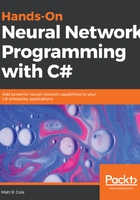
上QQ阅读APP看书,第一时间看更新
A visual guide to neural networks
In this section, I could type thousands of words trying to describe all of the combinations of neural networks and what they look like. However, no amount of words would do any better than the diagram that follows:

Reprinted with permission, Copyright Asimov Institute
Source: http://www.asimovinstitute.org/neural-network-zoo/
Source: http://www.asimovinstitute.org/neural-network-zoo/
Let's talk about a few of the more common networks from the previous diagram:
- Perceptron: This is the simplest feed-forward neural network available, and, as you can see, it does not contain any hidden layers:

- Feed-forward network: This network is perhaps the simplest type of artificial neural network devised. It contains multiple neurons (nodes) arranged in layers. Nodes from adjacent layers have connections or edges between them. Each connection has weights associated with them:

- Recurrent neural network (RNN): RNNs are called recurrent because they perform the same task for every element of a sequence, with the output depending on the previous computations. They are also able to look back at previous steps, which form a sort of short-term memory:
